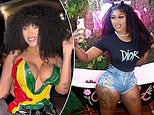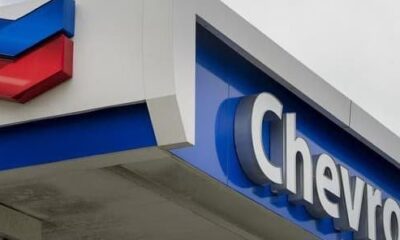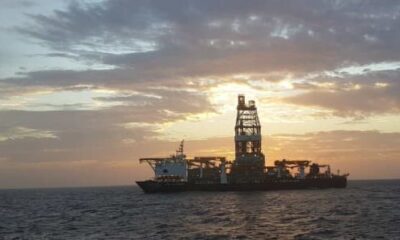Business
Suriname Eyes Oil Prosperity as Explorations Gain Momentum

Suriname is positioning itself for a significant oil sector expansion, drawing comparisons with its neighbor, Guyana, which has rapidly transformed into a leading offshore oil producer. The geological landscape suggests potential, but the pace and scale of Suriname’s development remain uncertain. Recent developments indicate that Suriname will focus on its Block 58, operated by TotalEnergies and APA Corporation, with the first production expected in 2028.
Guyana’s offshore oil journey began with the discovery of the Liza-1 well by ExxonMobil in 2015, leading to first oil in 2019. Currently, production from the Stabroek Block exceeds 660,000 barrels per day, with estimates of reserves ranging from 11 to 13 billion barrels. The swift development in Guyana resulted from a substantial investment by ExxonMobil and its partners, Hess and CNOOC, who have deployed multiple floating production, storage, and offloading (FPSO) units.
The economic impact of Guyana’s oil boom has been profound, funding infrastructure projects and increasing public sector wages. Despite these gains, challenges persist, particularly in regulatory frameworks and developing domestic technical capacities. In contrast, Suriname has only recently turned its attention to oil exploration, leveraging the same hydrocarbon-rich basin as Guyana.
Exploration in Suriname intensified in 2020, focusing primarily on Block 58. This area is now seen as the most promising for oil development. A final investment decision for Gran Morgu, within Block 58, was confirmed in late 2024, with expectations of peak production between 200,000 and 220,000 barrels per day and reserves estimated at around 700 million barrels. The state oil company, Staatsolie, holds a 20% stake in this venture.
However, not all exploration efforts in Suriname have yielded positive results. Block 59 has faced significant setbacks, with major operators like ExxonMobil and Equinor withdrawing due to exploration difficulties. The block lies in deep water, ranging from 2,700 to over 3,500 meters, complicating drilling efforts. The challenges have led to the block being returned to Staatsolie, reflecting a cautious approach by international investors.
In terms of geology, while Block 58 benefits from favorable conditions, Block 59’s positioning along a geologic margin increases the risk of unsuccessful ventures. Shell’s recent drilling in Block 65, which did not encounter commercial-quality rocks, further underscored the uncertainties facing Suriname’s deepwater ambitions. Analysts have characterized this as a “data-gathering opportunity,” reinforcing the importance of thorough seismic interpretation and careful exploration strategies.
Despite these challenges, the outlook remains cautiously optimistic. Industry analysts from Rystad Energy project that up to 10 wells could be drilled in Suriname’s offshore sector by the end of 2026, highlighting the potential for further discoveries. TotalEnergies and APA are expected to invest between $9 billion and $10 billion into the Gran Morgu project, a significant sum for a country with a modest oil production history.
To support this growth, Staatsolie has initiated training programs and academic partnerships aimed at enhancing local capacities. TotalEnergies has also pledged to aid in the development of domestic suppliers. Nevertheless, the scale of required improvements in engineering, logistics, and regulatory frameworks presents considerable challenges.
Political dynamics also play a crucial role in Suriname’s oil aspirations. The recent elections in May 2025 resulted in a narrow victory for the National Democratic Party (NDP) and the appointment of Jennifer Geerlings-Simons as the new president. Her administration has committed to maintaining continuity in energy policies while emphasizing social investment.
So far, the operational environment in Suriname has remained stable, but the relinquishment of Block 59 serves as a reminder of the complexities involved in deepwater drilling. While Block 58 has shown commercial viability, the geological risks associated with other leads cannot be overlooked.
Suriname’s potential as a competitive regional oil producer hinges on its ability to navigate these challenges effectively. The next few years leading up to first oil in 2028 will be critical. Institutional readiness, infrastructure development, and public engagement will be essential in determining whether Suriname can fully realize its oil ambitions, with decisions made in Paramaribo shaping the future of its energy sector.
-

 World3 days ago
World3 days agoCoronation Street’s Shocking Murder Twist Reveals Family Secrets
-

 Entertainment4 months ago
Entertainment4 months agoKate Garraway Sells £2 Million Home Amid Financial Struggles
-

 Entertainment3 months ago
Entertainment3 months agoAnn Ming Reflects on ITV’s ‘I Fought the Law’ Drama
-

 Health3 months ago
Health3 months agoKatie Price Faces New Health Concerns After Cancer Symptoms Resurface
-

 Entertainment3 weeks ago
Entertainment3 weeks agoCoronation Street Fans React as Todd Faces Heartbreaking Choice
-

 World4 weeks ago
World4 weeks agoBailey Announces Heartbreaking Split from Rebecca After Reunion
-

 Entertainment6 days ago
Entertainment6 days agoTwo Stars Evicted from I’m A Celebrity Just Days Before Finale
-

 World6 days ago
World6 days agoKevin Sinfield Exceeds Fundraising Goal Ahead of Final Marathons
-

 Entertainment3 months ago
Entertainment3 months agoCoronation Street’s Carl Webster Faces Trouble with New Affairs
-

 Entertainment3 months ago
Entertainment3 months agoWhere is Tinder Swindler Simon Leviev? Latest Updates Revealed
-

 Entertainment4 months ago
Entertainment4 months agoMarkiplier Addresses AI Controversy During Livestream Response
-

 Science2 months ago
Science2 months agoBrian Cox Addresses Claims of Alien Probe in 3I/ATLAS Discovery





















